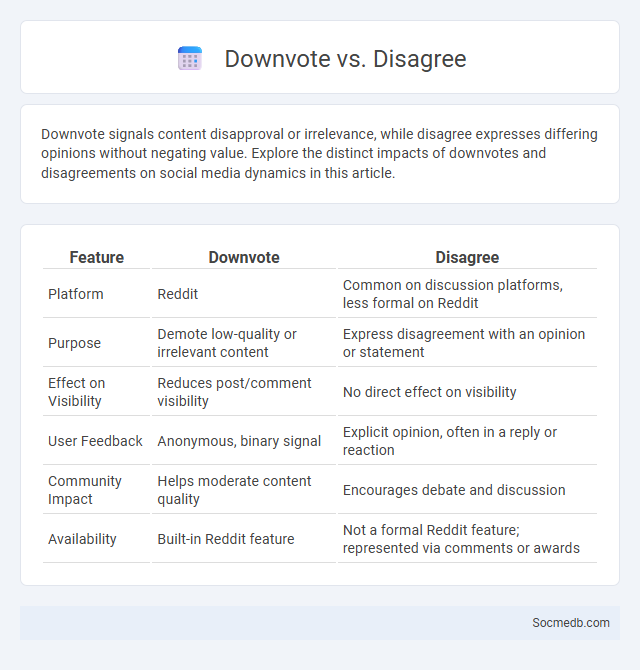
Photo illustration: Downvote vs Disagree
Downvote signals content disapproval or irrelevance, while disagree expresses differing opinions without negating value. Explore the distinct impacts of downvotes and disagreements on social media dynamics in this article.
Table of Comparison
| Feature | Downvote | Disagree |
|---|---|---|
| Platform | Common on discussion platforms, less formal on Reddit | |
| Purpose | Demote low-quality or irrelevant content | Express disagreement with an opinion or statement |
| Effect on Visibility | Reduces post/comment visibility | No direct effect on visibility |
| User Feedback | Anonymous, binary signal | Explicit opinion, often in a reply or reaction |
| Community Impact | Helps moderate content quality | Encourages debate and discussion |
| Availability | Built-in Reddit feature | Not a formal Reddit feature; represented via comments or awards |
Understanding Downvotes: Definition and Purpose
Downvotes serve as a user-driven feedback mechanism on social media platforms, indicating disapproval or disagreement with specific content. Their primary purpose is to help maintain quality and relevance by demoting low-value posts, comments, or replies, thereby improving the overall user experience. Understanding downvotes enables you to better navigate and contribute to online communities, fostering constructive interactions and content curation.
The Meaning of Disagree in Online Interactions
Disagreeing in online interactions often reflects diverse perspectives and critical thinking rather than conflict, emphasizing the importance of respectful communication. Understanding the meaning of disagree involves recognizing that differing opinions can foster constructive dialogue and promote empathy among users. Effective online disagreement requires clarity, openness, and an intent to engage rather than to alienate.
Downvote vs Disagree: Key Differences
Downvote and disagree serve distinct functions on social media platforms, with downvote typically reducing the visibility of content deemed irrelevant or inappropriate, while disagree expresses a user's opposing opinion without affecting content ranking. Your interaction by downvoting signals content quality control, helping platforms curate more relevant posts, whereas disagree reflects personal stance or debate engagement. Understanding these differences enhances how you influence community dynamics and content exposure effectively.
How Platforms Implement Downvotes and Disagree Options
Social media platforms implement downvotes and disagree options to enhance content moderation and user feedback mechanisms, enabling communities to surface relevant and high-quality posts while filtering out inappropriate or misleading information. These features often work through algorithms that consider the ratio of upvotes to downvotes or disagreement signals to adjust content visibility and ranking dynamically. By integrating downvote functions, platforms like Reddit and YouTube aim to promote healthier discussions and reduce spam or harmful content effectively.
Psychological Impact of Downvotes vs Disagree
Downvotes on social media often trigger negative psychological effects such as reduced self-esteem and increased feelings of rejection, whereas "disagree" responses can facilitate constructive dialogue by signaling opposing views without harming personal value. Your experience of online interactions is influenced by these feedback mechanisms, with downvotes tending to feel more personal and emotionally harmful compared to the relational distancing of disagreement. Understanding these differences helps in managing emotional responses and improving digital communication health.
Community Guidelines: When to Downvote or Disagree
Social media platforms enforce Community Guidelines to maintain respectful and constructive interactions, highlighting when you should downvote or disagree. Use downvotes thoughtfully for content that violates rules such as hate speech, misinformation, or harassment, ensuring your feedback supports a safer online environment. Express disagreements respectfully by focusing on facts and personal perspectives, fostering healthy, engaging discussions within your digital community.
Abuse and Misuse: Downvotes vs Disagree in Practice
Social media platforms often blur the line between downvotes and genuine disagreement, leading to misuse where downvotes become a tool for abuse rather than constructive feedback. Your experience can be negatively impacted when users weaponize downvotes to silence differing opinions instead of fostering healthy debate. Understanding this distinction is crucial to promoting respectful interactions and minimizing toxic behavior online.
Impact on Content Quality: Downvote or Disagree?
Social media platforms significantly influence content quality by amplifying user feedback mechanisms such as downvotes or disagreements, which can deter the spread of misinformation and low-quality posts. Your engagement, including the choice to downvote or disagree, helps algorithms prioritize valuable and accurate content while demoting misleading or irrelevant information. This dynamic shapes the overall content landscape, encouraging creators to maintain higher standards to gain positive user interactions.
Influencing Engagement: Metrics and User Behavior
Understanding engagement metrics such as likes, shares, comments, and click-through rates is crucial for optimizing your social media strategy. Analyzing user behavior patterns, including peak activity times and content preferences, allows you to tailor posts that resonate with your audience. You can increase visibility and foster deeper connections by leveraging these insights to create relevant, interactive content.
Best Practices for Using Downvote and Disagree Responsibly
Downvote and disagree buttons should be used to promote constructive feedback and highlight content that lacks relevance, accuracy, or civility on social media platforms. Users must avoid misusing these features as tools for personal bias, harassment, or suppressing diverse opinions, ensuring respectful discourse. Following community guidelines and fostering open dialogue enhances the quality of interactions and helps maintain positive online environments.
 socmedb.com
socmedb.com